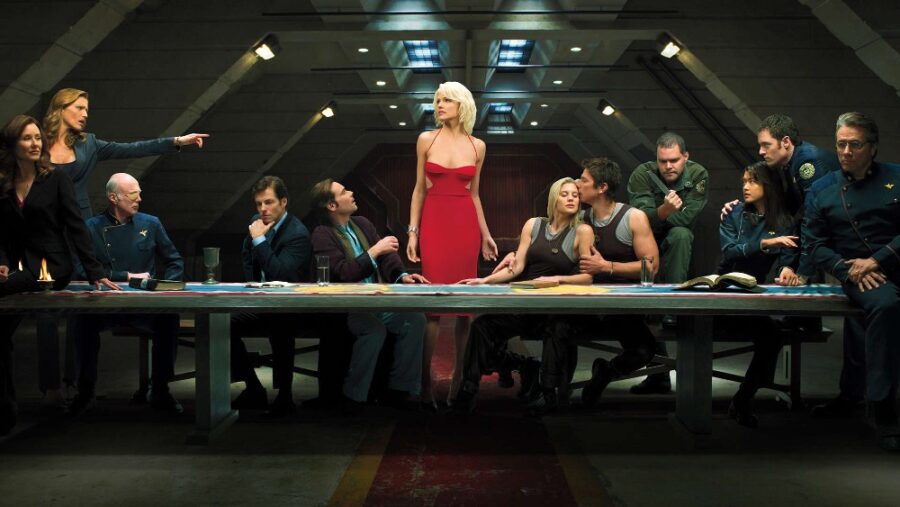The Battlestar Galactica Prequel Was Always Doomed To Failure And It’s Not The Show’s Fault

It’s hard for sci-fi shows to find a wide audience, which is why today, the majority of them are streaming service originals, but back in 2010, that wasn’t an option, and every show was scrambling to find something to hook in the audience and keep them watching. After the success of Battlestar Galactica, SyFy decided to give into the fan demands with a prequel series, Caprica, that would show the world before the Cylon rebellion. The hook used by the studio wasn’t “This is another smart sci-fi series about the nature of humanity,” no, it was “Here’s our star, and she’s nude.”
The Marketing Campaign

Before anyone saw a trailer or knew how Caprica would depict the world of Battlestar Galactica, the general public got to see Alessandra Torresani in a tasteful cheesecake pose, holding an apple. It turns out the important part of the image was the apple, which ties into the franchise’s use of biblical symbolism as her character, Zoe Graystone, would become an Eve-like figure. So it’s not completely cheesecake done for easy marketing, but, well, yes, it is.
It’s also hard to state now, decades later, that this one photo was found everywhere, from the sides of buses to billboards, as SyFy wanted to pull out all the stops to make Caprica a hit.
The Tragic Birth Of The Cylons

I caught every episode of Caprica as it aired, and up until just before the pilot launched, I could not tell you what the series was going to be about, except for a vague notion that it was the birth of the Cylons. The chrome-plated villains of Battlestar Galactica appeared in some of the marketing but were drowned out by Torresani, who, as we discovered during the pilot, was playing the original Cylon.
A series about grieving parents trying to bring back their dead daughter doesn’t have the same marketing jazz as plastering pictures of a Maxim model everywhere.
A Call Back To BSG’s Marketing

In Syfy’s defense, I’ll admit that a large part of the marketing behind the Battlestar Galactica remake was Number Six, played by model Tricia Helfer in her first major role, and the instantly iconic red dress. But that’s also part of the problem: Caprica’s marketing wasn’t breaking new ground, and in order to reach beyond the existing fanbase, it would have to, but unfortunately, never did. And I say that as someone who thought the series, though flawed, is still some of the best smart science-fiction ever made.
Not Even 2 Million Viewers At Its Peak

I’m not alone now, and importantly, I wasn’t alone back then, as Caprica debuted to strong ratings, topping off at 1.5 million for the mid-season finale. When it returned from hiatus, however, the audience didn’t return, prompting an early cancellation with five episodes left unaired (unless you were in Canada). Though the series gained viewers as it went along during the first few episodes, how many would have tuned in from the get-go if the marketing had bothered to explain what the series was really about?
As it turns out, not even SyFy knew what Caprica was going to be like for a long time, as the network was embroiled in a feud with Battlestar Galactica creator Ronald Moore over the show’s format. SyFy wanted standalone episodes with short story arcs, while Moore would bring back the success of the early seasons of BSG with longer, character-driven arcs. The result is a show that was confused from the start.
Themes Resonate Today

Again, it’s an absolute shame as what Caprica dug into over a decade ago is even more relevant today, from the ethics of artificial intelligence development to the dark underside of a society that outwardly claims to be beyond most social problems and the impact of social media. There are shows today trying to do the same thing and not doing it nearly as well.
Fans Will Always Wonder What Could Have Been

Smart, thought-provoking science fiction is one of the hardest genres to get right, and even when it is, it’s even harder to get eyeballs on it. Just look at The Expanse, one of the best hard sci-fi shows ever made, and it struggled for attention every single year. Caprica should have been a success; the building blocks are all there for a great sci-fi show. I’ll always wonder what could have been if the marketing hadn’t been so unbelievably tone-deaf.












